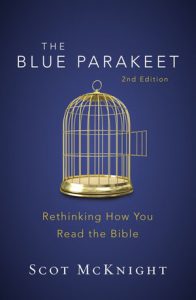 The Blue Parakeet: Rethinking How You Read the Bible
The Blue Parakeet: Rethinking How You Read the Bible
Scot McKnight
Thomas Nelson
Review by Keith Reed
What is the subject?
This book is a response to the question of how people can live out the Bible today.
Who is the author?
Scot McKnight (PhD, Nottingham) is the Julius R. Mantey Chair of New Testament at Northern Seminary (Illinois) and is a world-renowned speaker, author, and professor. He has written more than 60 books and actively shares his insights on Jesus Creed, a leading Christian blog.
Why this book?
 I was raised in a church that followed the “God said it, I believe it, that settles it” principle. However, what God “said” was really what the Bible “said”—more accurately, a specific interpretation of what is printed in the Bible.
I was raised in a church that followed the “God said it, I believe it, that settles it” principle. However, what God “said” was really what the Bible “said”—more accurately, a specific interpretation of what is printed in the Bible.
I have long been fascinated by the ways we choose to embrace and discount the words in the Bible and McKnight is not shy about tackling these questions. Furthermore, I felt it would be worthwhile to read this resource in advance of the 2019 Equip Study Conference, which will address biblical hermeneutics.
How is it in harmony with the MB Confession of Faith?
McKnight does not address specific issues related to the MB Confession of Faith, but he does use the questions of slavery, atonement, justice, and women in church ministries to demonstrate his interpretative approach. I suspect some readers will take exception to some of his conclusions, even though these do not contradict any of the 18 articles. One of the strengths of this book is how it will force readers to ask, “how do we interpret the Bible as MBs?”
Key insight
McKnight argues directly and convincingly that every Bible reader “picks and chooses” which parts of the Bible to live out, depending on the way they read the Bible. McKnight urges readers to interpret individual passages within the larger biblical story.
Where the book fails
I commend McKnight for using multiple examples to illustrate his “Bible as a wiki-story” method. However, he devotes a disproportionate chunk of his text to the question of women in church ministries. Following his hermeneutical approach so closely is certainly effective, but there were times when this question felt like it overshadowed the rest of his book and became a book within a book. Even so, his interpretation is extremely convincing, and his perspective is critical to the conversation.
Other relevant information
This is the second edition. It includes seven appendices.
Who should read it?
No Jesus follower will question the importance of interpreting Scripture, but many will admit that learning the hermeneutical process can be dull. McKnight does an exceptional job of explaining the process by mixing his teaching with personal stories, biblical case studies, and clever taglines. Any Jesus follower should read it and I estimate the reading level to be for adults 18 and older.
Favourite quotes
“We sometimes, rightly or wrongly, live out the Bible by not doing something in the Bible.”
“No matter who we are, when we open the Bible we read it through what we already believe.”
“The Bible is a Story; the Story is made up of a series of wiki-stories; the wiki-stories are held together by the Story; the only way to make sense of the blue parakeets in the Bible is to set each in the context of the Bible’s Story.”
[Keith Reed is a member of North Langley Community Church.
